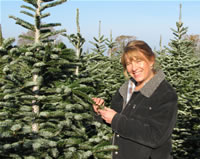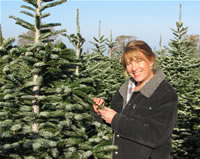UC studies new Christmas tree species in California
-
December 3, 2007
-
-
CONTACT: Jeannette Warnert
-
(559) 646-6074
-
jewarnert@ucdavis.edu
-
-
N / A
-
 See below for high-resolution version.El Dorado County Christmas tree grower Randy Rapetti believes he may have been the first farmer in California to plant Nordmann fir Christmas trees a few years ago, but the conifer is already showing great potential to brighten the holiday season for Californians who enjoy visiting choose-and-cut Christmas tree farms.Nordmann fir, native to Caucasus Mountains of Turkey and the Republic of Georgia, have a richer color than the much more common native species – such as Douglas and red fir – which make up the bulk of Christmas trees on Sierra foothill tree farms. The Nordmann’s open growth and strong branches are ideal for ornament display, Rapetti said.Perhaps more importantly, the exotic trees may be resistant to the insects and diseases that plague native Christmas trees, such as spider mites, aphids and root rot. Rapetti’s Nordmanns, planted in 2000, have required no pesticide treatments to date.Rapetti works closely with University of California Cooperative Extension farm advisor Lynn Wunderlich, who is coordinating Christmas tree research in El Dorado and Amador counties.An entomologist by training, Wunderlich began by studying Christmas tree pest problems when she was hired in 2000. She soon learned that there is wide genetic variability even within the species. Some of the new trees are resistant to local insect and disease problems, while others of the same species are not.Wunderlich is now evaluating the susceptibility of 12 sources of Nordmann and another exotic tree, Turkish fir, under naturally infested field conditions on Sierra foothill tree farms. Turkish fir looks the same as the Nordmann to the untrained eye. At close inspection, the Turkish can be distinguished by a tiny droplet of wax at the end of the needles.“The Christmas trees vary by provenance, which is their original area of origin, and progeny, seed collected from specific mother trees,” Wunderlich said. “We want to look at these trees’ potential resistance to Phytophthora cinnamoni root rot, a disease that impacts white and red fir trees growing here. It looks like the Nordmann and Turkish firs have some natural resistance.”In addition, Wunderlich is evaluating the growth and potential of the two exotic tree species for Christmas tree production in the California Sierra foothills.“The Nordmanns grow slowly when they’re first transplanted from the nursery,” Wunderlich said. “It seems its roots don’t like to be cut. But in time, the trees are catching up.”Wunderlich said another issue of concern with the Nordmann is very long “leader growth.” The leader is the very top vertical branch on which consumers often display a star or angel.“People will always come up to the foothills for the white and red fir, but now they will have two other tree species to choose from: the Nordmann and Turkish fir,” Wunderlich said.
See below for high-resolution version.El Dorado County Christmas tree grower Randy Rapetti believes he may have been the first farmer in California to plant Nordmann fir Christmas trees a few years ago, but the conifer is already showing great potential to brighten the holiday season for Californians who enjoy visiting choose-and-cut Christmas tree farms.Nordmann fir, native to Caucasus Mountains of Turkey and the Republic of Georgia, have a richer color than the much more common native species – such as Douglas and red fir – which make up the bulk of Christmas trees on Sierra foothill tree farms. The Nordmann’s open growth and strong branches are ideal for ornament display, Rapetti said.Perhaps more importantly, the exotic trees may be resistant to the insects and diseases that plague native Christmas trees, such as spider mites, aphids and root rot. Rapetti’s Nordmanns, planted in 2000, have required no pesticide treatments to date.Rapetti works closely with University of California Cooperative Extension farm advisor Lynn Wunderlich, who is coordinating Christmas tree research in El Dorado and Amador counties.An entomologist by training, Wunderlich began by studying Christmas tree pest problems when she was hired in 2000. She soon learned that there is wide genetic variability even within the species. Some of the new trees are resistant to local insect and disease problems, while others of the same species are not.Wunderlich is now evaluating the susceptibility of 12 sources of Nordmann and another exotic tree, Turkish fir, under naturally infested field conditions on Sierra foothill tree farms. Turkish fir looks the same as the Nordmann to the untrained eye. At close inspection, the Turkish can be distinguished by a tiny droplet of wax at the end of the needles.“The Christmas trees vary by provenance, which is their original area of origin, and progeny, seed collected from specific mother trees,” Wunderlich said. “We want to look at these trees’ potential resistance to Phytophthora cinnamoni root rot, a disease that impacts white and red fir trees growing here. It looks like the Nordmann and Turkish firs have some natural resistance.”In addition, Wunderlich is evaluating the growth and potential of the two exotic tree species for Christmas tree production in the California Sierra foothills.“The Nordmanns grow slowly when they’re first transplanted from the nursery,” Wunderlich said. “It seems its roots don’t like to be cut. But in time, the trees are catching up.”Wunderlich said another issue of concern with the Nordmann is very long “leader growth.” The leader is the very top vertical branch on which consumers often display a star or angel.“People will always come up to the foothills for the white and red fir, but now they will have two other tree species to choose from: the Nordmann and Turkish fir,” Wunderlich said.Media contact: Lynn Wunderlich, (530) 621-5505, lrwunderlich@ucdavis.edu
 Click for high-resolution version.
Click for high-resolution version.Lynn Wunderlich with Nordmann fir Christmas trees.

